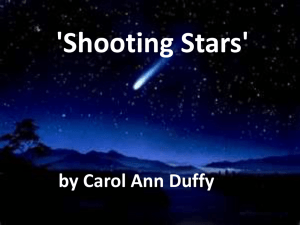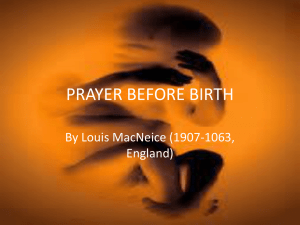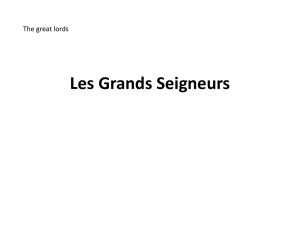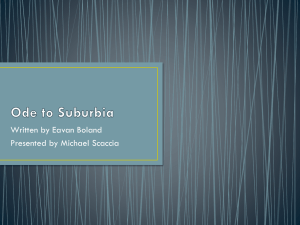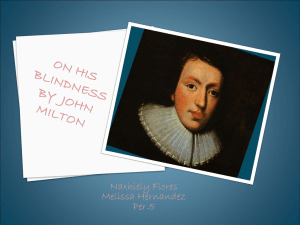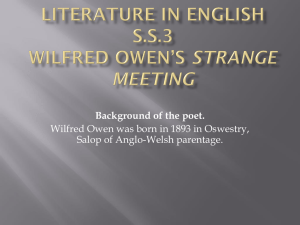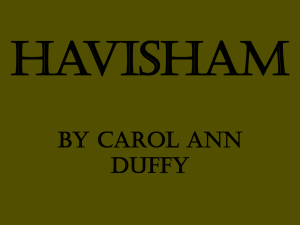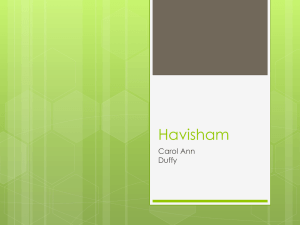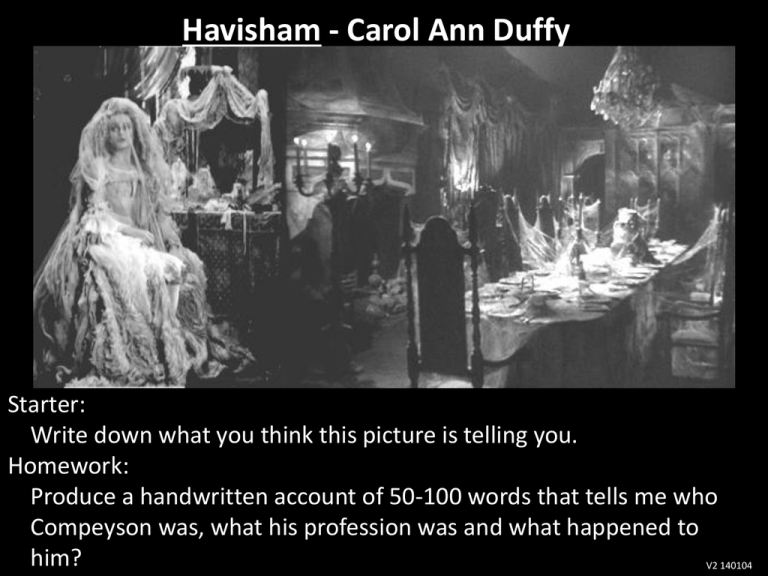
Havisham - Carol Ann Duffy
Starter:
Write down what you think this picture is telling you.
Homework:
Produce a handwritten account of 50-100 words that tells me who
Compeyson was, what his profession was and what happened to
him?
V2 140104
Havisham - Carol Ann Duffy
Learning Objectives:
As we study this poem you will learn about:
• The story of the poem
• The meaning of the title
• The source for the poem
• The poem’s themes
• Dialogue poems
• How the poem uses,
Symbolism & Metaphor: Enjambment: Tone: Imagery & Sensual
Imagery: Oxymoron.
• You will also complete some
summaries of slides, some
mini tasks, a quiz and an
assignment on the poem.
2
Havisham - Carol Ann Duffy
Beloved sweetheart bastard. Not a day since then
I haven't wished him dead. Prayed for it
so hard I've dark green pebbles for eyes,
ropes on the back of my hands I could strangle with.
Spinster. I stink and remember. Whole days
in bed cawing Nooooo at the wall; the dress
yellowing, trembling if I open the wardrobe;
the slewed mirror, full-length, her, myself, who did this
to me? Puce curses that are sounds not words.
Some nights better, the lost body over me,
my fluent tongue in its mouth in its ear
then down till suddenly bite awake. Love's
hate behind a white veil; a red balloon bursting
in my face. Bang. I stabbed at a wedding cake.
Give me a male corpse for a long slow honeymoon.
Don't think it's only the heart that b-b-b-breaks.
3
Havisham - Carol Ann Duffy
4
Background
Miss Havisham is a central character from Charles Dickens novel Great
Expectations (1861).
Before the story in the novel starts, Miss Havisham was jilted on her
wedding day and has remained in her house wearing her wedding dress from
that day onward. He dining room is still set with the wedding breakfast as it
was on her wedding day, nothing has been eaten (except by rats) or removed!
She has sworn revenge on the male sex and has brought up a beautiful
orphaned girl, Estelle who she uses to entrap men into falling in love with her.
Estelle then suddenly ends the relationship with the man and breaks their
hearts.
This poem imagines Miss Havisham speaking her feelings in a modern way
and is an outpouring of her bitterness and resentment.
Jilted: To deceive or drop a lover suddenly or callously, especially by
abandoning them on their wedding day.
Callous: Emotionally hardened; unfeeling: indifferent to the suffering of others.
Havisham - Carol Ann Duffy
Havisham
5
Mini Task 1
Look at the poem again and
Beloved sweetheart bastard. Not a day since then
from what you have just
I haven't wished him dead. Prayed for it
read about the background
so hard I've dark green pebbles for eyes,
ropes on the back of my hands I could strangle with.
to the poem, identify two
phrases from each stanza
Spinster. I stink and remember. Whole days
that help to create an
in bed cawing Nooooo at the wall; the dress
effective or accurate
yellowing, trembling if I open the wardrobe;
the slewed mirror, full-length, her, myself, who did this portrait of Miss Havisham.
to me? Puce curses that are sounds not words.
Some nights better, the lost body over me,
my fluent tongue in its mouth in its ear
then down till suddenly bite awake. Love's
hate behind a white veil; a red balloon bursting
in my face. Bang. I stabbed at a wedding cake.
Give me a male corpse for a long slow honeymoon.
Don't think it's only the heart that b-b-b-breaks.
Havisham - Carol Ann Duffy
6
Mini Task 1
The poem concentrates on the nature of the Miss Havisham's feelings and
the character's psychological/sexual nature. The absence of the formal title
‘Miss’ also makes the poem focus on her loss and spinster state. So the lines
for me which effectively communicate this are:
Stanza 1
‘Beloved sweetheart bastard’ : ‘wished him dead’ : ‘strangle with’
Stanza 2
‘Spinster’ : Stink and remember : ‘Nooooo’
Stanza 3
‘Puce curses‘ : ‘the lost body over me ‘Love’s….hate’ :
Stanza 4
‘Give me a male corpse ‘ : ‘I stabbed at a wedding cake ‘ : ‘heart that
b-b-b-breaks’
Havisham - Carol Ann Duffy
7
Havisham
Beloved sweetheart bastard. Not a day since then
I haven't wished him dead. Prayed for it
so hard I've dark green pebbles for eyes,
ropes on the back of my hands I could strangle with.
Spinster. I stink and remember. Whole days
in bed cawing Nooooo at the wall; the dress
yellowing, trembling if I open the wardrobe;
the slewed mirror, full-length, her, myself, who did this
to me? Puce curses that are sounds not words.
Some nights better, the lost body over me,
my fluent tongue in its mouth in its ear
then down till suddenly bite awake. Love's
hate behind a white veil; a red balloon bursting
in my face. Bang. I stabbed at a wedding cake.
Give me a male corpse for a long slow honeymoon.
Don't think it's only the heart that b-b-b-breaks.
Mini Task 2:
Write down what you
think is the ‘story of the
poem. (Be careful not to
write the story of the
story!)
Havisham - Carol Ann Duffy
8
Mini Task 2 : The Story of The poem (only summarise this)
This poem is a monologue spoken by Miss Havisham (a character in
Dickens' Great Expectations.) In the poem her legal title ‘Miss’ is omitted.
She begins by telling the reader the cause of her trouble, a man who she
describes as “beloved sweetheart bastard” which s a contradiction in terms, an
oxymoron. She tells us that she has prayed so hard, with eyes closed and hands
pressed together possibly clutching the ‘ropes’ of Rosary beads which she
could strangle with. Her eyes have shrunk to hard green stones which implies
jealousy and adds another motive to her murderous wish for revenge.
The second stanza starts with the word ‘Spinster’ which defines her unmarried
state and gives a clue as to why her ‘beloved sweetheart’ is a ‘bastard.’ She
then describes her physical and emotional state; she ‘stinks’ from having worn
her wedding dress for years without taking it off and her days in bed screaming
‘Nooooo’ show how emotionally damaged she is a result of being jilted. The
stanza finishes with her questioning ‘who did this.’
Havisham - Carol Ann Duffy
9
Mini Task 2 : The Story of The poem 2 (only summarise this)
The question from Stanza 2 continues in to Stanza 3. It is not answered as she
has done this to herself. Her fiancé might have been the cause of her
unhappiness, but she has chosen to continue her life wallowing in self pity. She
then talks about the anger she feels at the way she has been betrayed. This
ironically leads on to the fantasies she still has about her fiancé which show
that though she hates him for the humiliation he has caused her, she still love
him.
This is demonstrated by the oxymoronic enjambment that bridges the two
stanzas ‘Loves…hate’. And in Stanza three the anger turn violent as she
describes stabbing the wedding cake, a symbolic stabbing of her fiancé who
she now imagines as a corpse. The poem ends implying that her mind/spirt as
well as her heart has been broken.
Oxymoron: two words used together which have, or seem to have, opposite
meanings .
Havisham - Carol Ann Duffy
10
The poem in detail
Mini Task 3
1. On your copy of the poem, highlight/underline one key words or phrases
in from each line in Stanza 1.
2. What do you notice about the words you have underlined?
Beloved sweetheart bastard. Not a day since then
I haven't wished him dead. Prayed for it
so hard I've dark green pebbles for eyes,
ropes on the back of my hands I could strangle with.
Havisham - Carol Ann Duffy
The poem in detail
Mini Task 3
On your copy of the poem, highlight/underline what you think are the Key
Words/phrases in Stanza 1.
1) For me these are:
Beloved sweetheart bastard. Not a day since then
I haven't wished him dead. Prayed for it
so hard I've dark green pebbles for eyes,
ropes on the back of my hands I could strangle with.
2) They are words of hatred or violence.
Mini Task 4
What tone is established then at the start of the poem?
11
Havisham - Carol Ann Duffy
The poem in detail
Mini Task 4
What tone is established then at the start of the poem?
One of violence, anger and hatred.
12
Havisham - Carol Ann Duffy
13
The poem in detail
Beloved sweetheart bastard. Not a day since then
I haven't wished him dead. Prayed for it
so hard I've dark green pebbles for eyes,
ropes on the back of my hands I could strangle with.
This is an angry poem and this anger is established in the very first line
through the oxymoron ‘sweetheart bastard’ which is a combination of 'love'
(beloved sweetheart) and hatred (bastard). And in case you have not got the
message form the opening line we are then told that not a day has passed
since she was jilted that she has not wished her fiancé ‘dead.’
In writing this poem, Duffy assumes the reader possesses some knowledge of
Dickens's character as she does not reference or explain anything about the
circumstance that have lead up to this point in Miss Havisham’s life. What
would seem to interest Duffy is Miss Havisham simultaneously loving and
hating her ‘fiancée'; two opposing emotions which are at constantly at war
with each other within her.
Mini Task 5: Summarise this slide.
Havisham - Carol Ann Duffy
The poem in detail
Beloved sweetheart bastard. Not a day since then
I haven't wished him dead. Prayed for it
so hard I've dark green pebbles for eyes,
ropes on the back of my hands I could strangle with.
Mini Task 6
Identify the metaphor that is used in this stanza.
14
Havisham - Carol Ann Duffy
The poem in detail
Beloved sweetheart bastard. Not a day since then
I haven't wished him dead. Prayed for it
so hard I've dark green pebbles for eyes,
ropes on the back of my hands I could strangle with.
Mini Task 6
Explain the metaphor that is used here?
15
Havisham - Carol Ann Duffy
16
The poem in detail
Beloved sweetheart bastard. Not a day since then
I haven't wished him dead. Prayed for it
so hard I've dark green pebbles for eyes,
ropes on the back of my hands I could strangle with.
Her anger/hatred is so great that she has even asked for divine assistance to
help her wreak her revenge…..
…..And her eyes have metaphorically become hard stones.
If eyes are the ‘window to the soul’ then her soul has
hardened too, enabling love to turn to hate.
Mini Task 7: If you haven’t explained the metaphor then
summarise this slide.
Havisham - Carol Ann Duffy
17
The poem in detail
Beloved sweetheart bastard. Not a day since then
I haven't wished him dead. Prayed for it
so hard I've dark green pebbles for eyes,
ropes on the back of my hands I could strangle with.
This is a Catholic reference to Rosary Beads, which Roman Catholics use as
an aid to counting prayers (and Carol Ann Duffy was brought up a Catholic.) As
this image leads on from prayers, the ‘rope’ is literal and not metaphorical
and creates an image of beads wrapped around her hand so tightly they look
like age swollen veins on the back of her hands.
And, of course, she would be quite capable
of strangling someone with them, even if only
in her imagination!
[Note: Most analysis of the poem sees the ‘ropes’ as a
metaphor for swollen veins on the back of her hands.]
Mini Task 8: Summarise this slide.
Havisham - Carol Ann Duffy
The poem in detail
Spinster. I stink and remember. Whole days
in bed cawing Nooooo at the wall; the dress
yellowing, trembling if I open the wardrobe;
the slewed mirror, full-length, her, myself, who did this
.
Mini Task 9
1. What tone is created by the first few words in this stanza?
2. How can you tell the first word is significant?
3. What is significant about ‘her, myself’?
4. What is significant about ‘trembling if’?
5. Write down what the key images are in this stanza.
6. What is significant about the end of this stanza?
18
Havisham - Carol Ann Duffy
19
The poem in detail
Spinster. I stink and remember. Whole days
in bed cawing Nooooo at the wall; the dress
yellowing, trembling if I open the wardrobe;
the slewed mirror, full-length, her, myself, who did this
.Mini Task 9
1. What tone is created by the first few words in this stanza.
The tone is angry. ‘Spinster’ feels like it is spat out in hatred . Being
followed by ‘I stink’ helps emphasise the anger (and sense of self-hatred)
created by the first word.
2. How can you tell the first word is significant?
It is a one word sentence, which always draws our attention to the word.
3. What is significant about ‘her, myself’?
She does not immediately see the reflection in the mirror as herself, but a
different person ‘her.’ Calling the reflection ‘her’ implies that what she
sees is a person she hates, in other words she hates herself!
Havisham - Carol Ann Duffy
20
Spinster. I stink and remember. Whole days
in bed cawing Nooooo at the wall; the dress
yellowing, trembling if I open the wardrobe;
the slewed mirror, full-length, her, myself, who did this
4. Write down what the key images are in this stanza.
I stink : Sensual (smell) imagery. After years of living in her wedding clothes.
in bed cawing Nooooo : A clear visual image of her crying in bed.
the dress yellowing : The dress should be white, but it has yellowed which
shows how long she has worn it.
trembling : in fear
mirror, full-length, her : Looking at herself in the mirror and hating the
woman she has become…..‘her’ not ‘me’.
Havisham - Carol Ann Duffy
20
Spinster. I stink and remember. Whole days
in bed cawing Nooooo at the wall; the dress
yellowing, trembling if I open the wardrobe;
the slewed mirror, full-length, her, myself, who did this
5. What is significant about ‘trembling if’?
‘if’ she opens the wardrobe, not ‘when’ she opens it. As she does not wear
any other clothes than her wedding dress she does not nee to look in her
wardrobe very often, but when she does she approaches the wardrobe
‘trembling’ in fear of seeing her reflection; and when she does see her
reflection she hates herself and asks who did this to her….the answer is of
course, herself (though she does try to blame her fiancé.)
6. What is significant about the end of this stanza?
Enjambment which asks the question she knows the answer to, but doesn't
want to admit. She has done this to herself and no one made her stay a
jilted bride, not even her fiancé who she blames for her spinsterhood.
Havisham - Carol Ann Duffy
The poem in detail
to me? Puce curses that are sounds not words.
Some nights better, the lost body over me,
my fluent tongue in its mouth in its ear
then down till suddenly bite awake. Love‘s
Mini Task 10
1. What is the main form of imagery in this stanza?
2. Why ‘puce curses’
Puce : a dark or brownish purple.
21
Havisham - Carol Ann Duffy
22
The poem in detail
to me? Puce curses that are sounds not words.
Some nights better, the lost body over me,
my fluent tongue in its mouth in its ear
then down till suddenly bite awake. Love‘s
Mini Task 10
1. What is the dominant form of imagery in this stanza?
Sensual/sexual imagery.
• ‘the lost body over me’ - a sexual act or possibly imagining the
consummation of her marriage on her wedding night.
• ‘fluent tongue in its mouth in its ear’ – there’s more than just ‘kissing’
here because her tongue is ‘fluent’ and knows what it is doing. She is
describing a sexual fantasy here, a fantasy that because she is trapped
in her jilted state must only ever exist in her imagination, never to be
real.
• ‘then down till suddenly bite’ Down where, bite what? A very violent
and disturbing image that shows the level of her hatred.
Havisham - Carol Ann Duffy
23
The poem in detail
to me? Puce curses that are sounds not words.
Some nights better, the lost body over me,
my fluent tongue in its mouth in its ear
then down till suddenly bite awake. Love‘s
Mini Task 10
2. Why ‘puce curses’
Puce : a dark or brownish purple.
I don’t think she means ‘puce’ at all, but has shortened ‘Pusillanimous’
which means :
1. lacking courage or resolution; cowardly; faint-hearted; timid.
2. proceeding from or indicating a cowardly spirit.
and this makes much more sense in the context of a poem where the
central character is beset by self-recrimination and self-loathing. In other
words she feels she lacks the courage to act, to do something positive.
Instead she just wallows in endless self-pity, blaming her fiancée and
never herself for her predicament.
Havisham - Carol Ann Duffy
The poem in detail
then down till suddenly bite awake. Love‘s
hate behind a white veil; a red balloon bursting
Mini Task 11
What do you notice about the move from Stanza 3 to 4?
24
Havisham - Carol Ann Duffy
The poem in detail
then down till suddenly bite awake. Love‘s
hate behind a white veil; a red balloon bursting
Mini Task 11
What do you notice about the move from Stanza 3 to 4?
Enjambment….but this time it leads to the
second oxymoron in the poem ‘Love’s …. Hate’.
The fact that the oxymoron straddles the two
stanzas highlights the unstable nature of
Havisham's emotions. It also acts as a
commentary on the stanza as it moves from
the sensual imagery and ‘Love’ of Stanza 3 to
the from the violent and embitterment of
the ‘hate’ in Stanza 4.
25
Havisham - Carol Ann Duffy
The poem in detail
hate behind a white veil; a red balloon bursting
in my face. Bang. I stabbed at a wedding cake.
Give me a male corpse for a long slow honeymoon.
Don't think it's only the heart that b-b-b-breaks.
Mini Task 12
1. Select one Key Word from each line and write it down.
2. Explain why you have chosen the words you have selected.
3. Explain what the red balloon might symbolise.
4. What should be behind the white veil?
26
Havisham - Carol Ann Duffy
27
hate behind a white veil; a red balloon bursting
in my face. Bang. I stabbed at a wedding cake.
Give me a male corpse for a long slow honeymoon.
Don't think it's only the heart that b-b-b-breaks.
Mini Task 12
1. Select one Key Word from each line and write it down.
For me these are:
‘bursting’ : ‘stabbed’ : ‘corpse’ : ‘b-b-b-breaks’
2. Explain why you have chosen the words you have selected.
The first three are violent. She stabs the cake, but in her imagination is
stabbing her fiancé, who of course then becomes the corpse in the next
line. The last is perhaps what the whole poem has been about. Miss
Havisham has not only got a broken heart but a broken soul, mind, life and
future prospects and the shattering of the word reflects the shattering of
her life.
You could have as easily chosen ‘hate’ : ‘Bang’ : ‘honeymoon’ or ‘heart’
instead of the words above. The choice is yours, the justification is what is
important.
Havisham - Carol Ann Duffy
28
The poem in detail
hate behind a white veil; a red balloon bursting
in my face. Bang. I stabbed at a wedding cake.
Give me a male corpse for a long slow honeymoon.
Don't think it's only the heart that b-b-b-breaks.
Mini Task 12
3. Explain what the red balloon might symbolise.
The red balloon bursting is an odd, if interesting image. Whenever you
get the contrast between red and white in a poem with violent imagery,
the red usually symbolises blood in some way. As we have the reference to
‘hate’ before it and ‘stabbed’ in the next line, I feel the balloon represents
her fiancée's ‘blood’ is as it sprays over her white wedding gown as she
stabs him.
4. What should be behind the white veil?
It should be a face of love behind the wedding veil, not a face of hate.
Vocabulary - Symbolism: The practice of representing things by means of
symbols or of attributing symbolic meanings or significance to objects,
events, or relationships.
Havisham - Carol Ann Duffy
Form & Structure
Mini Task 13
1. How is the poem structured?
2. What form does the poem take?
3. What are the poem’s Key Features?
4. Look at the whole poem and find one example of:
• assonance
• alliteration.
• Internal rhyme
• Onomatopoeia
5. On your copy of the
poem use arrows
to indicate enjambment.
29
Havisham - Carol Ann Duffy
Form & Structure
Mini Task 13
1. How is the poem structured?
4 stanzas of 4 lines. Free verse with 10-12 syllables per line.
2. What form does the poem take?
Monologue.
3. What are the poem’s Key Features?
Visual imagery and sensual imagery.
3. Find one example of
• assonance
• alliteration
• Internal rhyme
• Onomatopoeia
29
Havisham - Carol Ann Duffy
Form & Structure
Mini Task 13
1. How is the poem structured?
4 stanzas of 4 lines. Free verse with 10-12 syllables per line.
2. What form does the poem take?
Monologue.
3. What are the poem’s Key Features?
Visual imagery and sensual imagery : Enjambment.
4. Find one example of
• assonance
hard - dark : Puce curses : lost body over : long slow honeymoon
fluent tongue
• alliteration
Beloved - bastard : me a male : balloon bursting
• Internal rhyme
yellowing, trembling : Spinster – remember : cawing - wall;
• Onomatopoeia
Bang : b-b-b-breaks.
31
Havisham - Carol Ann Duffy
5. Enjambment
Beloved sweetheart bastard. Not a day since then
I haven't wished him dead. Prayed for it
so hard I've dark green pebbles for eyes,
ropes on the back of my hands I could strangle with.
Spinster. I stink and remember. Whole days
in bed cawing Nooooo at the wall; the dress
yellowing, trembling if I open the wardrobe;
the slewed mirror, full-length, her, myself, who did this
to me? Puce curses that are sounds not words.
Some nights better, the lost body over me,
my fluent tongue in its mouth in its ear
then down till suddenly bite awake. Love's
hate behind a white veil; a red balloon bursting
in my face. Bang. I stabbed at a wedding cake.
Give me a male corpse for a long slow honeymoon.
Don't think it's only the heart that b-b-b-breaks.
33
Havisham - Carol Ann Duffy
34
Assignment
‘Miss Havisham has been driven mad by her desire for revenge. Lady Macbeth
has been driven mad by guilt.’
Using examples from the play and poem to support your answer, discuss to
what extent you agree or disagree with the above statement.
600-800 words by Thursday 27 Feb.
There is a very good American site with analysis of the poem. See
http://www.shmoop.com/havisham-duffy/
…and a good article about Miss Havisham in Wikipedia. See:
http://en.wikipedia.org/wiki/Miss_Havisham


